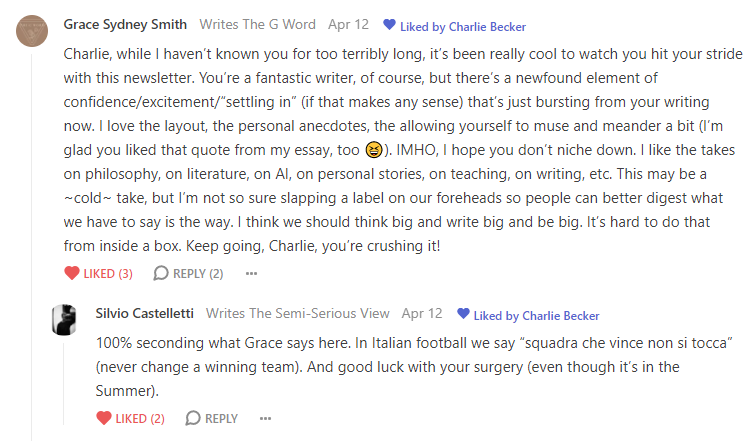"The real voyage of discovery consists not in seeking new landscapes, but in having new eyes." — Marcel Proust
My name is Charlie I write essays, fiction, and commentary at Castles in the Sky. I also send this newsletter every Wednesday to share personal updates alongside ideas I'm germinating and cool things I read or found. To find all my essays, fiction, commentary, and past newsletter issues, check the archive here. Leave a 💗 if you like the issue.
In this issue, I explore two of my "Twelve Favorite Problems." Twelve Favorite Problems is a concept popularized by physicist Richard Feynman that encourages keeping a dozen important problems in mind posed as questions to test new ideas against, helping us focus on what truly matters.
I first learned about it in Write of Passage, and it has shaped the way I approach and refine my thoughts on the issues I care about most. I have organized the rest of this issue according to two of those questions and Crowd Work:
How do I bring the spirit of travel to where I live, and balance travel and putting down roots: In this section, I share my "theory of travel" as well as two excerpts from writers I like.
How should I focus my reading and writing to create more of what I want to see in the world? I share three things I read recently and some brief thoughts.
Crowd Work: Looking at some of last week’s mentions and comments.
How do I bring the spirit of travel to where I live, and balance travel and putting down roots?
I love to travel, but I have also always dreamt of being a “pillar of the community.” This tension has created two questions. The first is more obvious: how do I balance traveling a lot and putting down roots? The second is more subtle: how do I get the benefits of travel without leaving my hometown—in other words, how do I bring the spirit of travel to where I live?
Coincidentally, two of my friends on Substack touched on this recently. First, in a shower thought from
at :The more I travel, the less I feel pressured to go see places. As I start to understand my own preferences— this erratic "tourist mindset" fades. I'm a lifestyle traveler. I need my coffee shop, my gym, my place to work, to sleep. I love to be surrounded by people in big cities. I’m not so much an outdoors person as the last thing I want to do is go hiking or sit on a beach. For me happiness is everything and I’ll fight for the lifestyle I want to live.
Then,
at had a great article called Why You Shouldn't Try to Travel Like a Local where she argued that the concept of "traveling like a local" can be more insidious than it appears, as it might lead to reductive thinking and ignorance about the complexities of the place being visited. She suggests that travelers should not focus solely on authenticity, but rather on being a good guest, appreciating their privilege, and understanding that they can never truly experience what it is like to live in a place. (You should read the whole article, it’s great.)It is not necessarily always best to “search for authenticity.” Leo knows himself, and so tries to make a certain part of his experience uniform across his travels (as he lives in twelve countries over twelve months). Samantha explains that looking for the “one true” authentic representative of a place means that you are forcing preconceived notions onto the places you’re going. I think that they both raise a good implicit point, which is that you need to be in touch with yourself to really get to know a place.
I feel a little closer to answering my question. Bringing the spirit of travel to where I live can mean that, like Leo, I grow to know myself well enough that I know the places I want to experience new things, and the places where I like familiarity and routine. This will allow me to focus on meaningful travel experiences. And balancing putting down roots and travel means that, like Samantha, I understand that there are certain experiences I will never fully have access to. By knowing myself better and approaching the world with curiosity and respect, I can bring the spirit of travel to places I go every day.
How should I focus my reading and writing to create more of what I want to see in the world?
These are some interesting things I read or encountered this week that I thought were worth sharing and discussing.
End-of-Life Dreams: A hospice doctor makes sense of our final visions by Paul Laritzen in Commonweal Magazine
This is just a fabulously thought-provoking essay about Dr. Christopher Kerr, a hospice doctor who is doing research to provide evidence for what hospice workers have always known: that end of live dreams and visions (ELDVs) are common, therapeutically important, and frequently predictive of imminent death.
The Long Tail of Aphex Twin’s ‘Avril 14th’ by Eric Drucker in the New York Times
Avril 14th is among my favorite songs of all time. It is a short piano composition from electronic musician Richard James who makes music under the moniker Aphex Twin. I am not the only one who loves it, as it has inspired Andy Samberg, Kanye West, and countless others.
Last year, Eric Drucker did a fantastic job of chronicling the song’s long life inspiring other artists. I think a big part of what makes the song so popular is how beautiful it is but how simple it seems.
captures the idea of beautiful simplicity super well in one of his logs in January:Simplicity often has a secret complexity. Great works can be appreciated both at the surface and in the depths. Think of a Beatles song. After one listen, you might like the song, but after the 5th listen, you realize, ‘whoa, I never heard that layer before.’ (Also true for art, architecture, writing, etc.). There’s so much richness that it can’t all be absorbed in one sitting. It’s important that complexity isn’t distracting for a first-timer— it’s elegantly organized, waiting to be noticed.
The reason I loved this article, aside from being an enormous fan of Aphex Twin and this song in particular, is because of what I think is an unexplored side of simplicity. Namely, how generative a good, simple piece of art can be for other artists. I’ve been riffing on the art of covers, and how interesting and appealing an imperfect copy of something can be (which is actually a great segue into the next link).
The Five Obstructions by Lars von Trier and Jørgen Leth
I just heard about this older movie, where filmmaker Lars von Trier challenges Jørgen Leth, his friend and mentor, to remake Leth’s acclaimed short film The Perfect Human five times. Leth has to remake the film with five times with obstructions put in place by von Trier that get more severe and idiosyncratic as they go on.
This inspired me, so I am going to do a project to celebrate one year of being on Substack by rewriting the first essay I published on Substack in a similar fashion. That essay is A Dirge for Eastern Redwoods.
Write it backwards. Reverse the order of each paragraph.
Do it again but inverse it, so that your Uncle Dain becomes a metaphor for Eastern Redwood.
Write the essay as a series of haikus or short poems, capturing the essence of the Eastern Redwoods and their significance.
Write it as a rhyming poem.
Write it in reporting style like how a news anchor would say it on the radio.
Write the essay as a fictional story set in a world where Eastern Redwoods still exist and are the center of the characters' lives, revealing their significance through the narrative.
Weave 5 pictures of Eastern Redwoods into the peace.
Write the essay from the perspective of an Eastern Redwood tree, detailing its life, experiences, and eventual demise.
Write it through the lens of a fictional character in 1st person.
If you have any of these you particularly like, or want to recommend one, comment below!
Crowd Work
Here are some of my favorite comments and shout-outs from last week. Leave your own this week if you’ve liked something so far!
Comment on Castles in the Sky 29
Grace and Silvia had some really nice, encouraging things to say in the last issue.
Mentioned in chasing answers newsletter #50
Randy was kind enough to mention me in a roundup of newsletters he liked.
I love reading Charlie Becker's newsletter, Castles in the Sky, because I never know what I am going to get, but I know it will be good. Charlie can write anything, from summaries of others' work to personal stories, fiction, and even philosophical pieces that will leave you thinking. His newsletter is a great place for inspiration. My favorite work of Charlie's is his fictional piece, The Masculine Urge to Visit a Psychic Giraffe in Khartoum. I'm not a big fiction reader, but it definitely left me wanting more.
He is in luck because I have big plans for Sami in the future.









Write the essay from the perspective of an insect that relied on the eastern redwood for its life.
Write the essay from the perspective of another tree that was in competition with eastern redwoods and wanted to see them go extinct.
Love this exercise.
I agree with the thoughtful compliments from your readers.
You are a gifted writer with a unique and unexpected perspective.